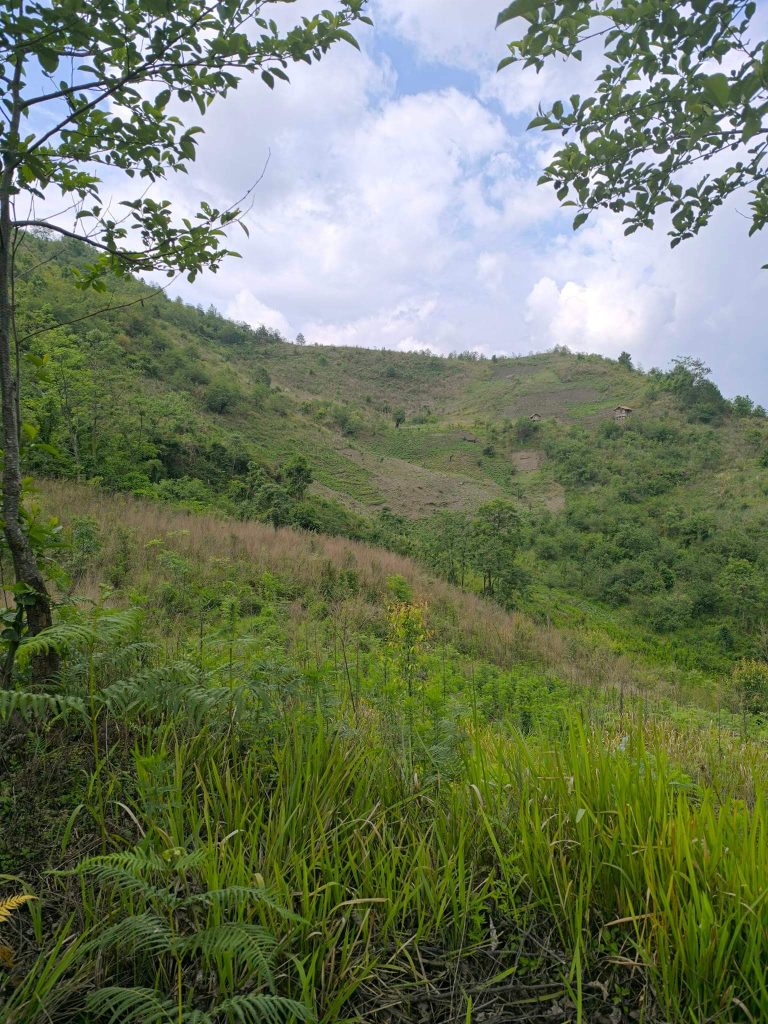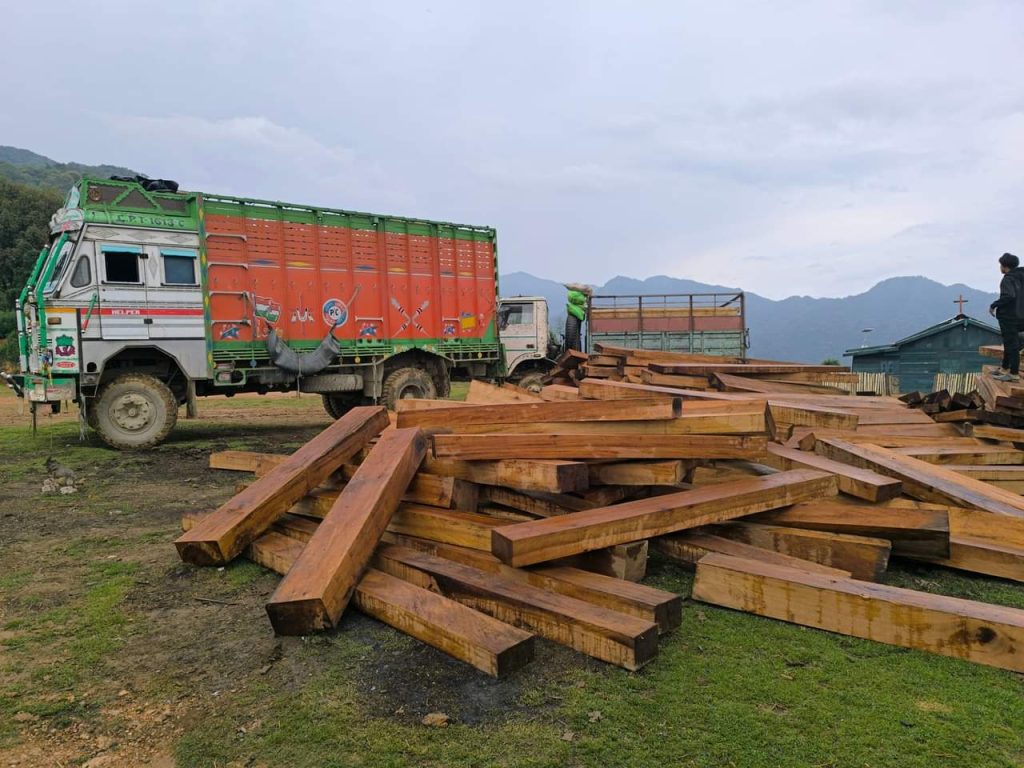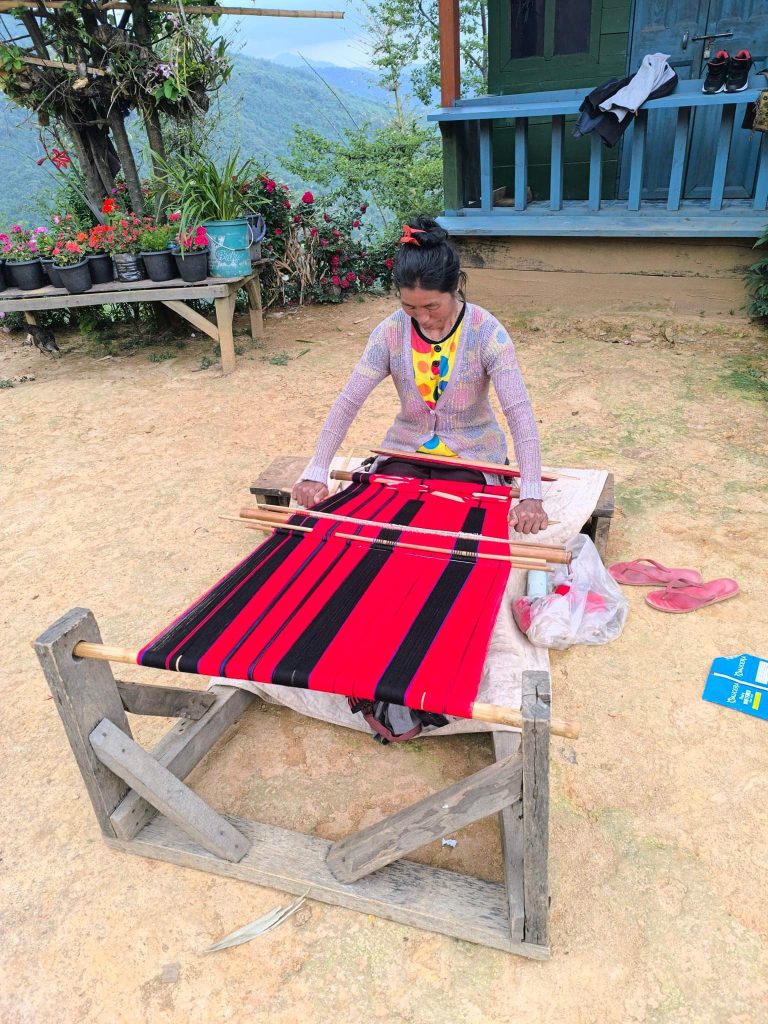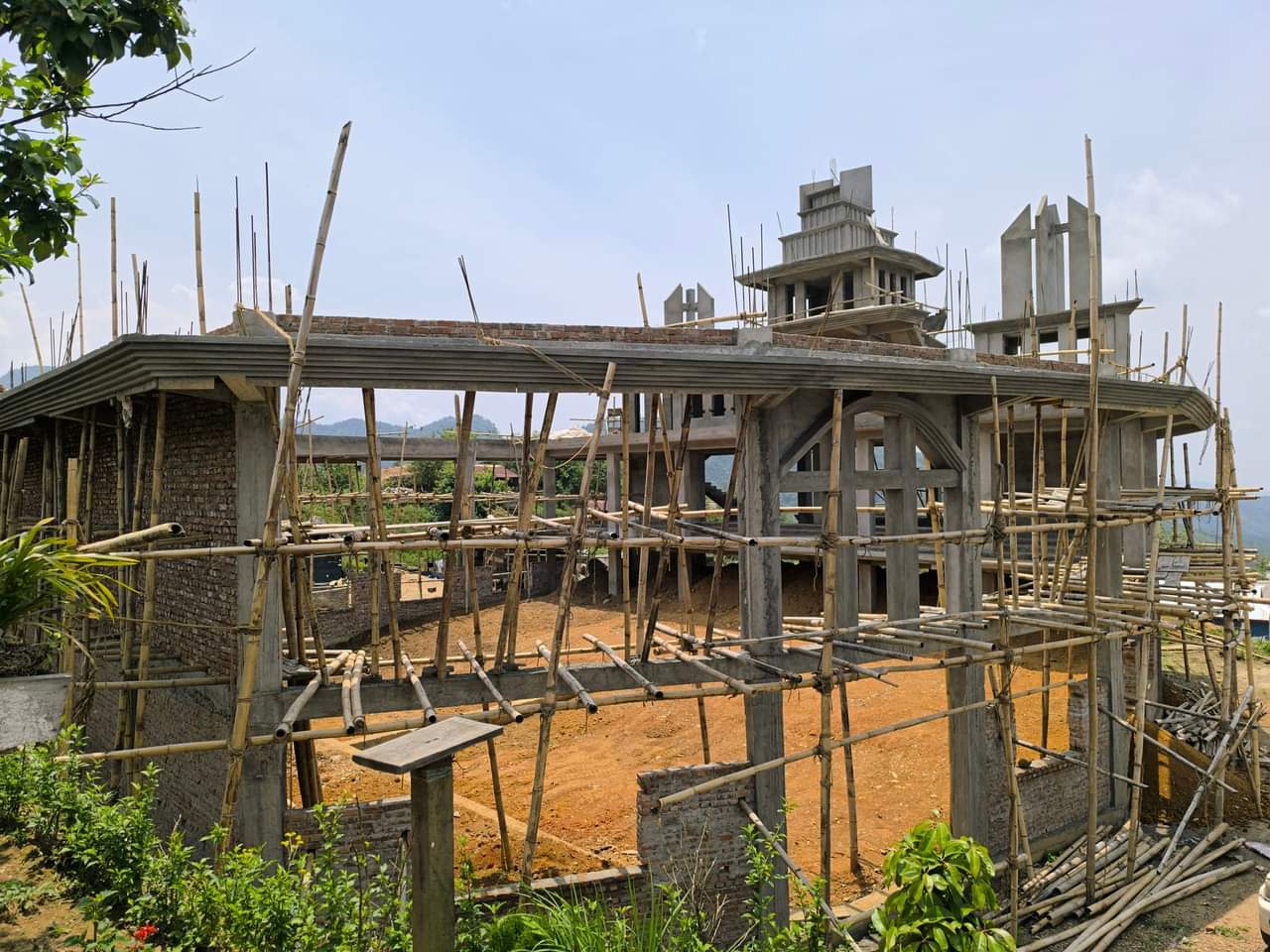Thanamir is a small, quaint village in the Kiphire district of Nagaland, India, located at an altitude of over 2000 m. It is one of the last villages on the Indian side of the Indo-Myanmar border, and residents speak the unique Chirr dialect. Thanamir is famous for its organic apples and holds an apple festival every year in September in the Khongsa circle of Kiphire district after the first harvest. The village is located 15 km from the sub-district headquarters at Khongsa and 83 km from the district headquarters at Kiphire. In Nagaland, rivers, mountains, stones, and trees often serve as natural boundaries, and for Thanamir, the boundary is the tranquil Limkhimro River. The river here is pure, clean, and unpolluted, a sight that brings immense satisfaction, as this is not often the case in other areas.
The village serves as the final stop for trekkers embarking on the journey to the towering Mt. Saramati, the highest peak in Nagaland. Since it is a border village, the Indian government has established an Assam Rifles checkpoint to ensure security in the area. At this checkpoint, all vehicles are required to stop and must provide the information requested by the authorities.
As one nears the eastern border of Nagaland, the steep, shaven hills provide evidence of the widespread practice of indigenous jhum cultivation. Jhum cultivation, also known as slash and burn, involves the clearing of forest land for crop growth, and the land is then left fallow after one or two growing cycles. It is a significant part of traditional agriculture in Eastern Nagaland. After arriving, one of our first impressions of the village was the spirited children having a great time playing together on the playground. When we met the Village Council Chairman (VCC), he made us feel very welcome. This created a positive and hopeful atmosphere and set the tone for our research endeavour.
Discovering Thanamir: Where Land Meets Culture
Thanamir village has a lot to offer adventurous travellers: the majestic Mt. Saramati, the red-rhododendron-covered hills, the rich flora and fauna of the community-protected forest, and the friendly faces of Thanamir people. It has two verdant reserve forests. One is the Thanamir Village Student Union reserve forest with an expanse of over 200 hectares, which was established in 1973 under the guidance of Mr. H. Athong to preserve it for future generations. As the name suggests, the students’ reserve forest is maintained by the students themselves and includes an area for growing native medicinal plants. In addition, there is a well-preserved community-reserve forest maintained by the Thanamir Citizen Union that was initiated in 2005 with the help of Mr. T. Shuto, a former Village Chairman. In these dense forests, the flora and fauna are abundant, as logging and hunting have been strictly banned, with a hefty fine of 50,000 INR for offenders. The main difference between the two forests is that in the Student Union Reserve Forest, the collection of both flora and fauna is strictly prohibited, whereas in the community-reserve forest, one can gather leafy wild leaves either for personal use or for livestock feed.

The village has a Mithun Committee established with the support of the Animal Husbandry Department under the Government of Nagaland. The Committee was formed in 2011 and cares for a special reserved area, fenced off so that the mithuns (semi-domesticated Bos frontalis) can roam freely. Mithuns are important in Naga culture and rituals. When two friends (or community members) have a dispute, one friend will kill a mithun and share the meat with the other in the first year. The next year, the other friend does the same to make peace. At present, there are about 200 to 300 mithuns, with each household caring for a small herd. The formation of the Mithun Committee was seen as a great initiative by the villagers, as in the past, the mithuns would destroy fields and water sources.
On our first visit to Thanamir, we got the opportunity to trek to one of the high viewpoints, which overlooks Mt. Saramati. Mt. Saramati, known in the local dialect as Meramkhanvong, meaning ‘the blazing mountain’, stands at an altitude of 3841 metres and sits on the border between Nagaland and Myanmar. On our way through the reserved forest to the viewing point, we were lucky to see many deep red rhododendrons, the state flower of Nagaland, and wild orchids. After a lovely two-hour walk during which we asked our guide many questions, we reached the top, relishing the sound of the sweet chirping of birds, the smell of fresh air, the lush green forest, and the beauty of the majestic Mt. Saramati before us.
Climate Change: Insights from the Village
Local reports from villagers in Thanamir suggest significant changes in weather patterns over the past two to three decades. These include warmer temperatures, changes in the timing of the apple harvest season, shifts in rainfall patterns, and drier conditions in April and May. Those we spoke to reported that farmers are facing difficulty understanding the best time for planting due to seasonal variation, resulting in poor crop growth and reduced yields. Additionally, one respondent reported that there has been an increase in mosquitoes, which were not a problem a few years ago. A respondent in his 50s remarked, ‘Back then, it used to even snow everywhere in the village (in January); there was lots, but now it has changed. There is no more snow.’ While some perceive that deforestation is the reason behind the warming climate, others blame the practice of jhum cultivation and the burning of fields.

Cultivating Hope: Community Apple Project
The Apple Community Project, or Jiang Vong Apple Project, was launched in 2010 with the hope that it would provide better and easier livelihoods for the village. Thanamir, like other parts of Eastern Nagaland, is relatively poor, and so many of the villagers hope that the increased apple harvests will help to increase household incomes. Each household possesses a sizeable plot of former jhum land to support an apple orchard. On average, each household cultivates between 100 and 200 apple trees, with some families recently setting up new orchards in former jhum fields they have acquired from other villagers. In interviews, each respondent expressed optimism about apple cultivation. The village has shifted from cultivating cereal crops to cash crops for a more sustainable livelihood, yet they keep some traditional practices alive by planting millet, rice, and Job’s tears. On average, each tree produces about 40–50 kilogrammes of apples, which sell for about 150 INR per kilogramme and 100 INR if they sell in bulk. The village uses an organic method and solely relies on natural fertilisers and rainfall for irrigation. In 2011, the village held its first apple festival. Mr. Tangkit, an Ao missionary, connected the villagers to the right people, which led to an increase in apple trees in the village. Through his efforts, numerous apple saplings were procured, boosting the growth of apple trees in the village, and encouraging the initiation of the Community Apple Project.

Logging for Faith: Religion and Conservation
Thanamir is one of the first villages in Nagaland to come up with the idea of forest conservation. In the past, before apple plantations became so common, the timber business served as a good source of income for many households. However, due to a noticeable decrease in flora and fauna, the village leaders decided to introduce a logging ban. And yet, as rigorous as the rules regarding the protection of the reserved forests are, logging activities are allowed to help generate funds for a huge new church in the centre of the village. When we were visiting, large piles of timber lay at the entrance to the village, which had been taken from the reserved community forest land, to be sold in urban centres like Dimapur and Kohima. It was mentioned that the timber from the community forest is of excellent quality and can only be cut down to raise funds for the construction of the church. One of the student executive members expressed regret over the excess logging of timber but could not find any solution, as they do not have alternative options to fund the church construction. This highlights the importance of religion to the community. They proudly say that everyone has converted from animism to Christianity. All the villagers belong to the Baptist Church, and other denominations are barred to keep the community united in their faith.

Development and Politics: Seeking Statehood
Despite being a beautiful and welcoming community, respondents in Thanamir also expressed dissatisfaction, reflecting the long-standing grievances of the Eastern Nagaland people against both the Indian Government and the Nagaland state authorities. Thanamir is part of the eastern region of Nagaland, which can be readily identified by the vast area of jhum cultivation and the poor road conditions. Eastern Nagaland comprises six districts: Mon, Tuensang, Kiphire, Longleng, Noklak, and Shamator, which are inhabited by the seven tribes of Chang, Khiamniungan, Konyak, Phom, Sangtam, Tikhir, and Yimkhiung. The Eastern Nagaland People’s Organisation (ENPO), a political organisation, has been demanding a separate ‘Frontier Nagaland’ state since 2010, alleging ‘negligence’ by the Nagaland government in all aspects of development after 60 years of statehood (under the Indian constitution). In one of our conversations, a respondent emphatically said, ‘We’re not asking for extra; we just want what belongs to us’. As part of their efforts to gain separate statehood, all villagers in Eastern Nagaland have abstained from taking part in the Lok Sabha election and the Urban Local Body (ULB) election. They have also organised bans on all private and business travel in the hope of having their demands met. The ENPO jurisdiction constitutes about 45% of the total Nagaland state population, and it is an under-developed, underprivileged, and neglected area with only 3% employment in the state public service, of which 95% are Grade VI employees. This is compounded by poor quality education, healthcare, and human resources development, including roads and communications (Cheerangal, 2022). People within Thanamir also expressed their respect for the ENPO in our discussions and want a separate state to help support their development and livelihood needs.
Conclusion
In closing, we found that Thanamir demonstrates intricate interconnections between conservation undertakings, timber extraction, faith and community-based projects, and its relationship to broader national and development-related politics. The charm of the village lies in its serene weather and beautiful landscape. Nestled in the isolated eastern area of Nagaland, the villagers, influenced by Christianity and education, have shifted from subsistence crops to cash crops in the hope of a better livelihood, but they still feel a lack of support from the state.
Although Thanamir, with its enchanting mountains and abundant wildlife, has the potential to be one of Nagaland’s tourist hotspots, the poor road conditions, and uneven distribution of development funds between the eastern and western areas of Nagaland pose a significant challenge for local people. In the absence of access to state development funds, the village has resorted to logging in the reserve forest to secure funds for church building. What the future holds for Thanamir is still unknown in the face of a changing climate and political conditions that locals understand will continue to bring change.
Reference
Cheerangal, F. S. (2022). The Yimkhiung Nagas (pp. 89-90). Heritage Publishing House.
Exploring Eden: Tales from the Apple Village
By Sholu Movi and Lu Chi
MyCClimate Researchers


